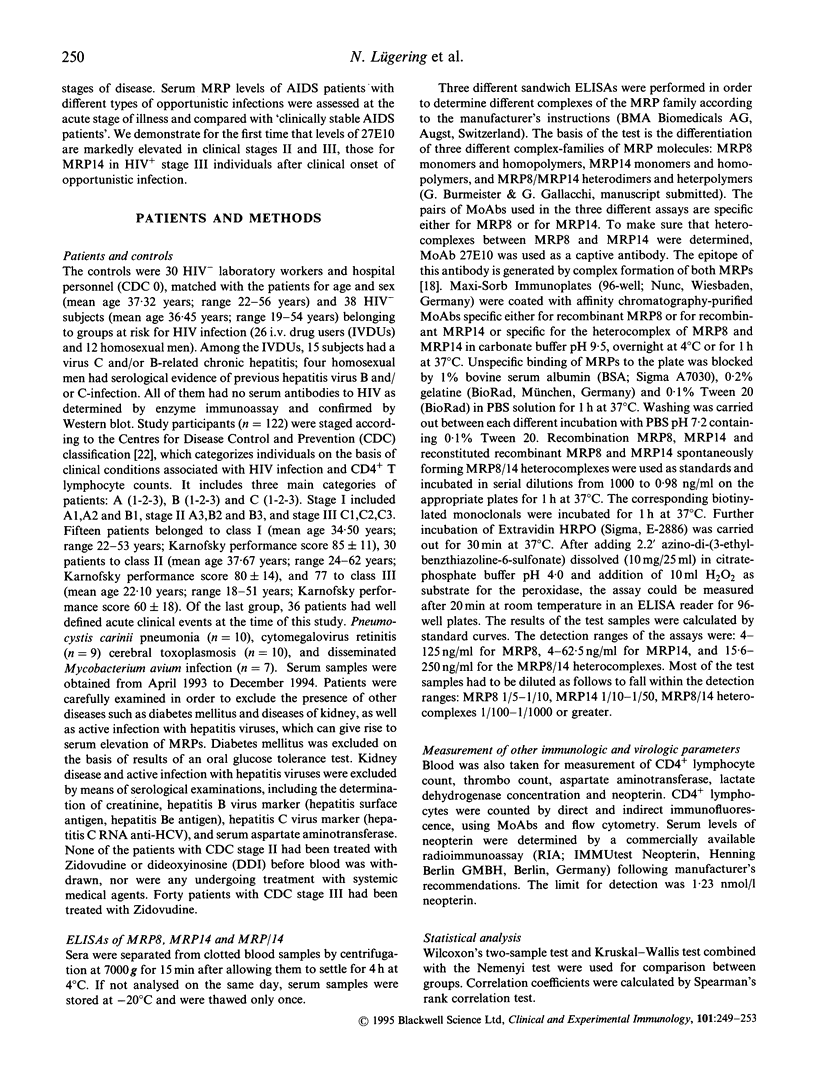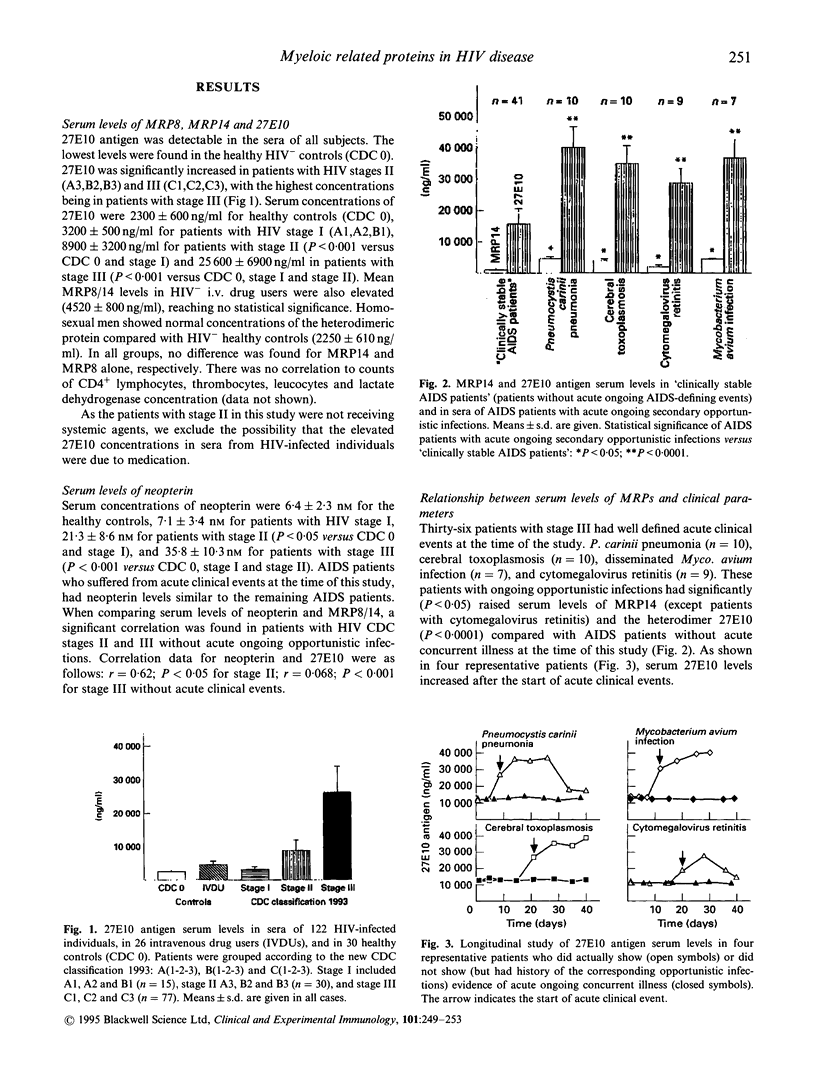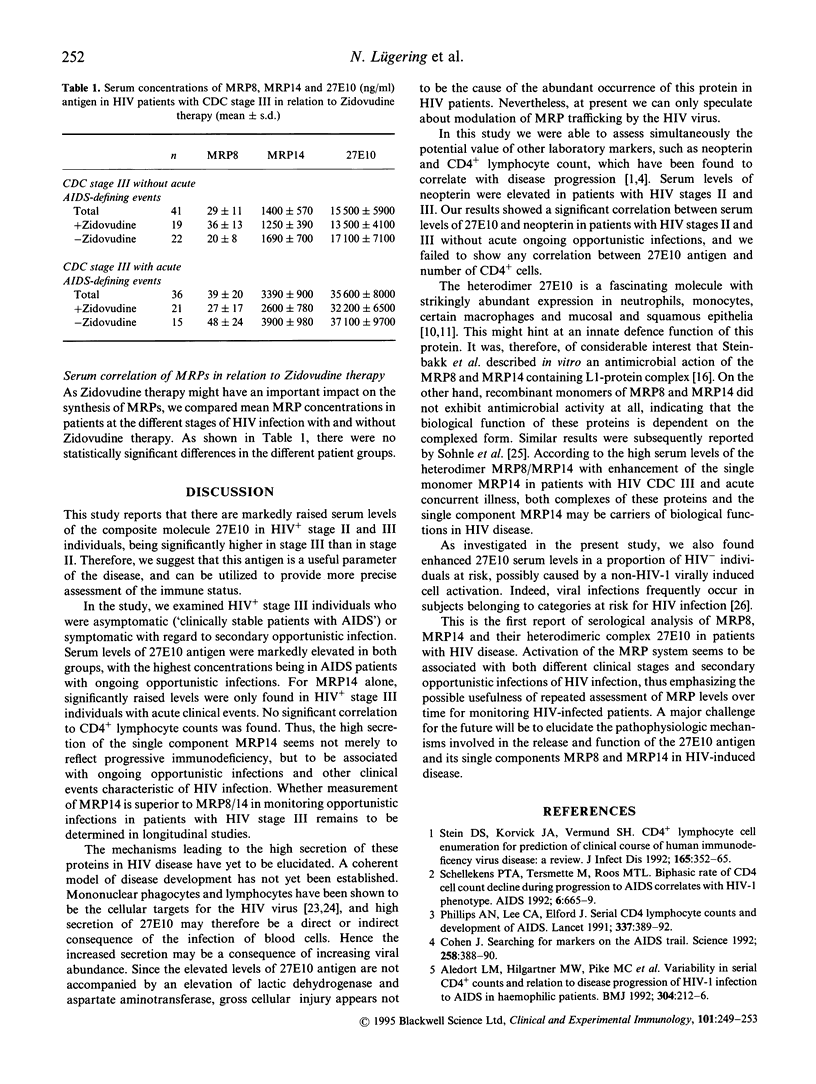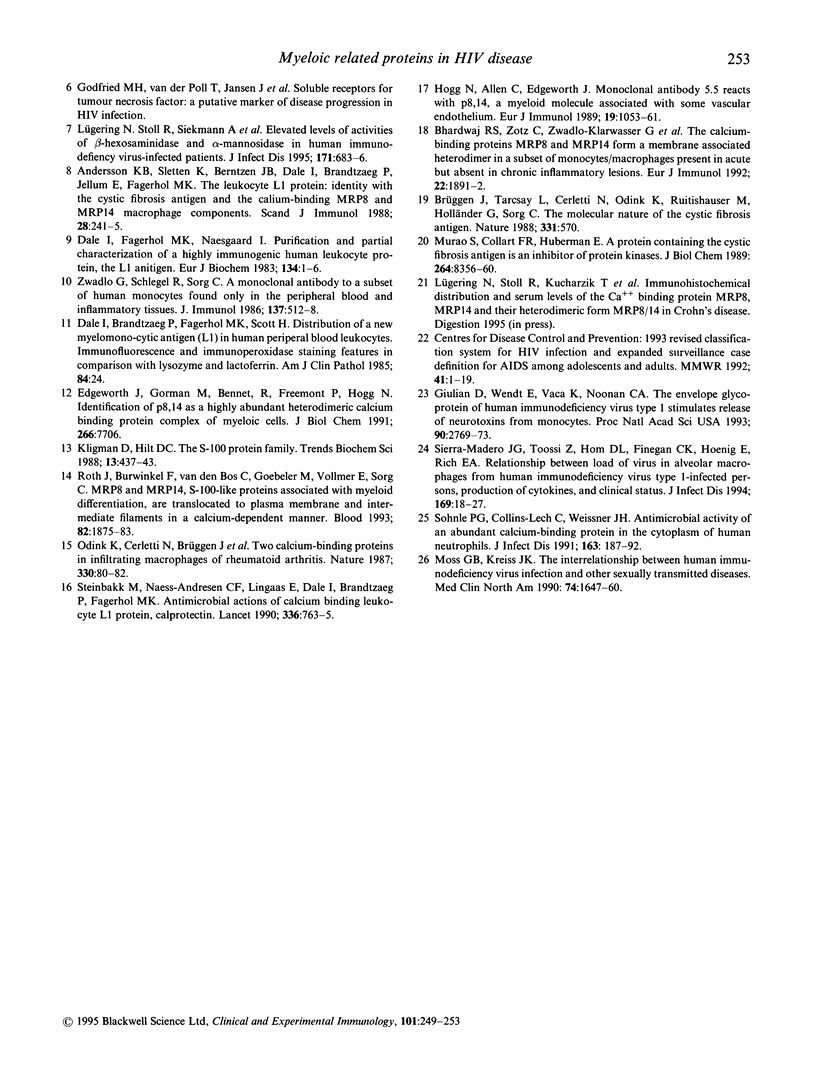Abstract
MRP8 and MRP14 are myeloic related proteins expressed by most circulating and emigrated neutrophils and monocytes. Their composite molecule MRP8/14 (27E10 antigen) was shown to exhibit striking antimicrobial properties. The aim of the present study was to assess the value of MRPs as markers for detection of the different stages of HIV infection (Centres for Disease Control and Prevention, 1993). By employing the ELISA technique we measured serum concentrations of these proteins in samples from 122 HIV patients at the various stages of disease, and the results were compared with those for healthy controls. Serum levels of the heterodimeric molecule 27E10 were significantly increased (P < 0.001) in patients with CDC stages II and III, with the highest levels being in patients with stage III and acute ongoing opportunistic infections. For the single component MRP14, significantly raised levels (P < 0.05) were only found in HIV stage III individuals with acute clinical events. Similar associations were not found for MRP8 alone. Increase was not related to CD4+ cell count. There was a significant correlation between 27E10 antigen serum concentrations and levels of neopterin in patients with HIV stages II and III without acute concurrent illness. Patients being treated with Zidovudine showed no statistically significant variation in levels of 27E10 and its single components MRP8 and MRP14 compared with untreated patients. These findings suggest that elevation of MRP14 levels occurs in HIV+ individuals at later stages post-HIV infection, after the onset of opportunistic infections. 27E10 antigen is concluded to be a potential marker for the different stages of HIV disease.
Full text
PDF




Selected References
These references are in PubMed. This may not be the complete list of references from this article.
- Aledort L. M., Hilgartner M. W., Pike M. C., Gjerset G. F., Koerper M. A., Lian E. Y., Lusher J. M., Mosley J. W. Variability in serial CD4 counts and relation to progression of HIV-I infection to AIDS in haemophilic patients. Transfusion Safety Study Group. BMJ. 1992 Jan 25;304(6821):212–216. doi: 10.1136/bmj.304.6821.212. [DOI] [PMC free article] [PubMed] [Google Scholar]
- Andersson K. B., Sletten K., Berntzen H. B., Dale I., Brandtzaeg P., Jellum E., Fagerhol M. K. The leucocyte L1 protein: identity with the cystic fibrosis antigen and the calcium-binding MRP-8 and MRP-14 macrophage components. Scand J Immunol. 1988 Aug;28(2):241–245. doi: 10.1111/j.1365-3083.1988.tb02437.x. [DOI] [PubMed] [Google Scholar]
- Bhardwaj R. S., Zotz C., Zwadlo-Klarwasser G., Roth J., Goebeler M., Mahnke K., Falk M., Meinardus-Hager G., Sorg C. The calcium-binding proteins MRP8 and MRP14 form a membrane-associated heterodimer in a subset of monocytes/macrophages present in acute but absent in chronic inflammatory lesions. Eur J Immunol. 1992 Jul;22(7):1891–1897. doi: 10.1002/eji.1830220732. [DOI] [PubMed] [Google Scholar]
- Brüggen J., Tarcsay L., Cerletti N., Odink K., Rutishauser M., Holländer G., Sorg C. The molecular nature of the cystic fibrosis antigen. Nature. 1988 Feb 18;331(6157):570–570. doi: 10.1038/331570a0. [DOI] [PubMed] [Google Scholar]
- Cohen J. Searching for markers on the AIDS trail. Science. 1992 Oct 16;258(5081):388–390. doi: 10.1126/science.1357750. [DOI] [PubMed] [Google Scholar]
- Dale I., Brandtzaeg P., Fagerhol M. K., Scott H. Distribution of a new myelomonocytic antigen (L1) in human peripheral blood leukocytes. Immunofluorescence and immunoperoxidase staining features in comparison with lysozyme and lactoferrin. Am J Clin Pathol. 1985 Jul;84(1):24–34. doi: 10.1093/ajcp/84.1.24. [DOI] [PubMed] [Google Scholar]
- Dale I., Fagerhol M. K., Naesgaard I. Purification and partial characterization of a highly immunogenic human leukocyte protein, the L1 antigen. Eur J Biochem. 1983 Jul 15;134(1):1–6. doi: 10.1111/j.1432-1033.1983.tb07522.x. [DOI] [PubMed] [Google Scholar]
- Edgeworth J., Gorman M., Bennett R., Freemont P., Hogg N. Identification of p8,14 as a highly abundant heterodimeric calcium binding protein complex of myeloid cells. J Biol Chem. 1991 Apr 25;266(12):7706–7713. [PubMed] [Google Scholar]
- Giulian D., Wendt E., Vaca K., Noonan C. A. The envelope glycoprotein of human immunodeficiency virus type 1 stimulates release of neurotoxins from monocytes. Proc Natl Acad Sci U S A. 1993 Apr 1;90(7):2769–2773. doi: 10.1073/pnas.90.7.2769. [DOI] [PMC free article] [PubMed] [Google Scholar]
- Hogg N., Allen C., Edgeworth J. Monoclonal antibody 5.5 reacts with p8,14, a myeloid molecule associated with some vascular endothelium. Eur J Immunol. 1989 Jun;19(6):1053–1061. doi: 10.1002/eji.1830190615. [DOI] [PubMed] [Google Scholar]
- Kligman D., Hilt D. C. The S100 protein family. Trends Biochem Sci. 1988 Nov;13(11):437–443. doi: 10.1016/0968-0004(88)90218-6. [DOI] [PubMed] [Google Scholar]
- Lügering N., Stoll R., Siekmann A., Faulhaber J., Heese C., Dietrich O., Kucharzik T., Busch H., Hasilik A., Domschke W. Elevated levels of activities of beta-hexosaminidase and alpha-mannosidase in human immunodeficiency virus-infected patients. J Infect Dis. 1995 Mar;171(3):683–686. doi: 10.1093/infdis/171.3.683. [DOI] [PubMed] [Google Scholar]
- Moss G. B., Kreiss J. K. The interrelationship between human immunodeficiency virus infection and other sexually transmitted diseases. Med Clin North Am. 1990 Nov;74(6):1647–1660. doi: 10.1016/s0025-7125(16)30500-4. [DOI] [PubMed] [Google Scholar]
- Murao S., Collart F. R., Huberman E. A protein containing the cystic fibrosis antigen is an inhibitor of protein kinases. J Biol Chem. 1989 May 15;264(14):8356–8360. [PubMed] [Google Scholar]
- Odink K., Cerletti N., Brüggen J., Clerc R. G., Tarcsay L., Zwadlo G., Gerhards G., Schlegel R., Sorg C. Two calcium-binding proteins in infiltrate macrophages of rheumatoid arthritis. Nature. 1987 Nov 5;330(6143):80–82. doi: 10.1038/330080a0. [DOI] [PubMed] [Google Scholar]
- Phillips A. N., Lee C. A., Elford J., Janossy G., Timms A., Bofill M., Kernoff P. B. Serial CD4 lymphocyte counts and development of AIDS. Lancet. 1991 Feb 16;337(8738):389–392. doi: 10.1016/0140-6736(91)91166-r. [DOI] [PubMed] [Google Scholar]
- Roth J., Burwinkel F., van den Bos C., Goebeler M., Vollmer E., Sorg C. MRP8 and MRP14, S-100-like proteins associated with myeloid differentiation, are translocated to plasma membrane and intermediate filaments in a calcium-dependent manner. Blood. 1993 Sep 15;82(6):1875–1883. [PubMed] [Google Scholar]
- Schellekens P. T., Tersmette M., Roos M. T., Keet R. P., de Wolf F., Coutinho R. A., Miedema F. Biphasic rate of CD4+ cell count decline during progression to AIDS correlates with HIV-1 phenotype. AIDS. 1992 Jul;6(7):665–669. doi: 10.1097/00002030-199207000-00008. [DOI] [PubMed] [Google Scholar]
- Sierra-Madero J. G., Toossi Z., Hom D. L., Finegan C. K., Hoenig E., Rich E. A. Relationship between load of virus in alveolar macrophages from human immunodeficiency virus type 1-infected persons, production of cytokines, and clinical status. J Infect Dis. 1994 Jan;169(1):18–27. doi: 10.1093/infdis/169.1.18. [DOI] [PubMed] [Google Scholar]
- Sohnle P. G., Collins-Lech C., Wiessner J. H. Antimicrobial activity of an abundant calcium-binding protein in the cytoplasm of human neutrophils. J Infect Dis. 1991 Jan;163(1):187–192. doi: 10.1093/infdis/163.1.187. [DOI] [PubMed] [Google Scholar]
- Stein D. S., Korvick J. A., Vermund S. H. CD4+ lymphocyte cell enumeration for prediction of clinical course of human immunodeficiency virus disease: a review. J Infect Dis. 1992 Feb;165(2):352–363. doi: 10.1093/infdis/165.2.352. [DOI] [PubMed] [Google Scholar]
- Steinbakk M., Naess-Andresen C. F., Lingaas E., Dale I., Brandtzaeg P., Fagerhol M. K. Antimicrobial actions of calcium binding leucocyte L1 protein, calprotectin. Lancet. 1990 Sep 29;336(8718):763–765. doi: 10.1016/0140-6736(90)93237-j. [DOI] [PubMed] [Google Scholar]
- Zwadlo G., Schlegel R., Sorg C. A monoclonal antibody to a subset of human monocytes found only in the peripheral blood and inflammatory tissues. J Immunol. 1986 Jul 15;137(2):512–518. [PubMed] [Google Scholar]


